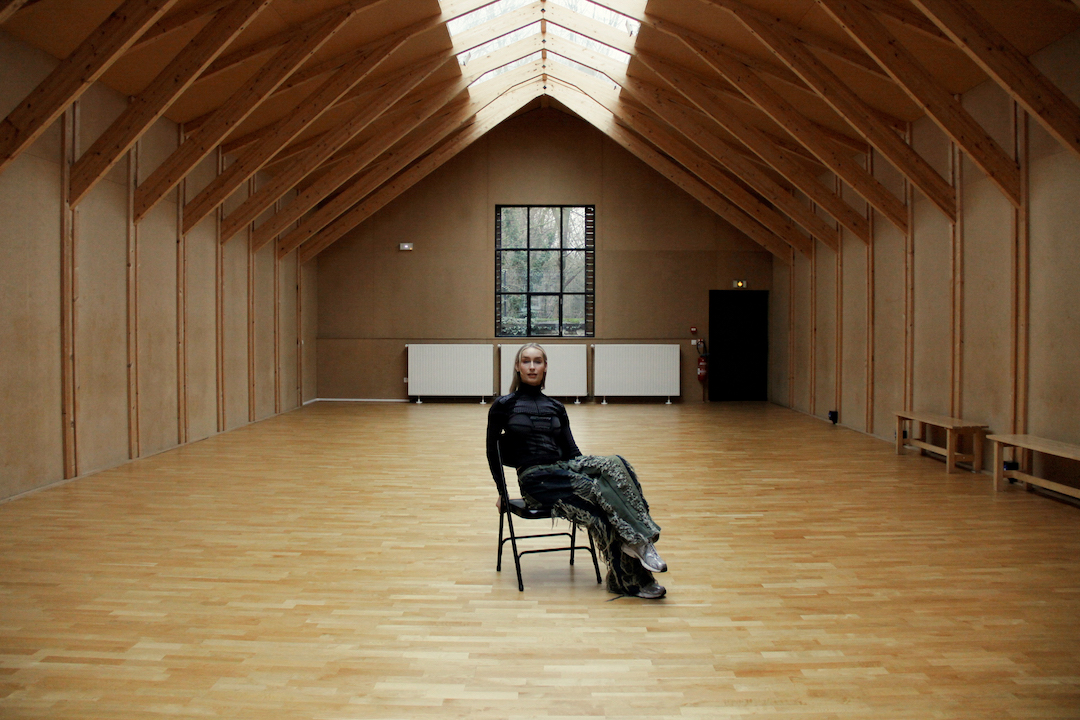Tiia Kasurinen is a Helsinki-based artist and a choreographer who graduated from Stockholm University of the Arts in 2017. She has just finished her artist residency at Cité des Arts in Paris, working on her latest stage piece Courtship Display (Birds of Paradise), set to premiere in Finland in 2026, as well as Songbird, a solo piece premiering later this spring in Malmö. In her work, Kasurinen is interested in themes such as identity, gender, the gaze and pop culture, which she explores through theatre make-up, visual transformation and motion.
We had the opportunity to follow her work at the studios of Atelier de Paris / CDCN, Centre de développement chorégraphique national, and discuss her residency at Cité des Arts as well as the main themes of her latest piece.
Could you tell us a little about the pieces you are currently working on?
I am currently working on two works at the Cité Internationale des Arts artist residency in Paris. Courtship Display (Birds of Paradise) is a group work set to premiere in Finland in 2026. The pilot of the work was seen last June in Paris at the finals of the Danse Élargie choreography competition. Songbird, on the other hand, is a solo work that will premiere this April in Sweden and in June in Finland.
You are currently in residency at the Cité des Arts. Could you tell us more about working in residency and what it means to you?
The desire to work in a residency originally arose from the need for a studio space. Dance work often requires a large space and it is unrealistic to have one in use all the time. Residencies have made it possible to work in new environments and different spaces. I feel that breaking away from my home environment gives me more ability to concentrate, like I am in a kind of residency bubble, where everyday and social responsibilities do not exist. A new environment and, for example, language and communication can be inspiring and get my thoughts flowing.
You are also working on your projects at the Atelier de Paris / CDCN studios for two weeks. What kind of experience has it been for you, and do you feel that a certain space shapes your work in a certain direction?
Atelier de Paris dance studio is particularly cozy, the space has inspired me to get back into my body and reminded me of different ways of moving. The large, bright and warm studio space is reminiscent of the dance studios at my university and it allows for the movement techniques that I practiced during my studies.
I’ve been dancing here a lot and reminding myself of different dance techniques. Instead of locking in choreographies, I’ve tried to be open to various materials. This has felt important, as working as an artist is often strongly linked to the production side, which can have an influence of truncating your own movement language. This week I have tried to remind myself of all the ways I can move and I feel like I needed this space for that.
What kind of themes do your new works deal with? The titles of both works refer to birds, could you tell us something about that?
The bird-referring titles were an accident, as neither of the works are really nature-themed. Courtship Display (Birds of Paradise) does, however, have a clearer reference to birds, specifically the colourful birds of paradise of Oceania. I became interested in these spectacular flamboyant birds a long time ago, especially the males of the species that perform crazy courtship dances. I think they are drag birds.
I find it interesting to delve into what courtship dances suggest about socially constructed gender roles, and the gendered nature of movement when the dance is brought into the human body or the world of drag.
The solo work Songbird, on the other hand, was inspired by working with sound. With the album I made for my previous work ONSTAGE – The Concert together with sound designer Olli Lautiola, I took singing lessons and became interested in using my voice on stage. “Songbird” is a nickname for a feminine character who sings or uses her own voice. I like the name, it is sarcastic to me and creates a contrast to the worlds the work may sometimes be in.
Later, after realising the bird connection between the works, I’ve considered them as a series of works. Courtship Display (Birds of Paradise) deals with the masculine drag king world, while Songbird is a character with a very feminine construction. I feel that the works influence each other in this way.
In previous works, you have also dealt with gender-related topics, such as feminine performances on social media and ultra-feminine aesthetics. This time you have chosen masculinity as one of the central themes of your new work, could you tell us more about that?
The concepts and stereotypes of femininity and femmeness have naturally interested me through my own life and experiences. Courtship display (Birds of Paradise) is like a soft landing into masculinity, since the male birds I deal with in the work and their courtship dances are truly unmasculine from the perspective of the human world.
Collaboration with other artists has deepened the work’s themes of masculinity and drag king aesthetics, especially through actor, dancer and drag king Lauri Lohi and textile designer Leevi Ikäheimo. The costumes for the performance are from Ikäheimo’s collection No Pain No Glamour.
The work also partly originated through the costumes. The bird of paradise theme had been on my mind for a long time, until it occurred to me that Leevi could lend me some costumes for the performance. Ikäheimo’s collection plays with extreme masculinity and an unrealistic image of masculinity. Through these costumes, human performances of masculinity came clearly into the work. The work thus expanded to consider all kinds of courtship dances that are perceived as masculine, which among people can be, for example, hierarchies of violence and dominance.
In addition, I have been really inspired by commercial dance. There is something threatening, and bold strength in this dance genre, which comes through femininity instead of masculinity. I see some unifying quality in courtship dances and commercial dance, which is reflected in my work. I find it fascinating to consider whether commercial dance is in a way a modern courtship dance, where the body is put in certain positions and the purpose of the movement is to look good and seductive.
You mentioned that in your work Courtship Display (Birds of Paradise) the outfits are from a collection of textile designer Leevi Ikäheimo. What role do costumes and makeup play in your work?
I am interested in a strong, recognisable visual world. Sometimes a certain transformation has been a ritual for me to start working, it inspires and makes me do things in a new way. Visual references are also a way to make viewers feel like they are included in the work.
I think of my works a bit like living photographs. I want to demonstrate the picture of time and what I see around me at that moment through visual transformation and motion. The result can also be a very exaggerated version of the surroundings.
Your works often feature current phenomena, such as the internet, social media and pop culture. You have mentioned in previous interviews that the internet is a pleasant and natural part of your life and your identity. Is there any criticism of these phenomena in your works?
I have a positive attitude towards these phenomena, as they have been a natural part of my life. Although there are also negative aspects to them, I do not criticise them in my works. I find it interesting to bring out a certain picture of the time and the internet has been an empowering place for many to express themselves in their own ways.
I find the internet to be a nice platform for self-expression, where I have been able to decide how I tell about myself or express myself. Of course, this also involves side effects, such as the algorithms that feed us information and their impact on self-expression.
My priority is not to make internet-critical works or critical works in general. My upcoming work Courtship Display (Birds of Paradise) is not a work that criticises masculinity, it is more of a collage of things that exist. The work can evoke emotions in one direction or another, and the interesting part of the work begins in the viewer’s own experience and interpretation.
Interview by Saija Kangasniemi and Linda Peltola
The project Courship Display (Birds of Paradise) is supported by Institut finlandais within the framework of the pARTir initiative, funded by the European Union – NextGenerationEU.


